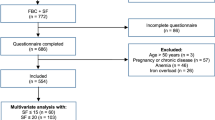Abstract
The iron status of a national sample of adults living in France and participating in the SU.VI.MAX cohort, was assessed using serum ferritin and hemoglobin concentrations. Complete data were obtained for 6648 women 35–60 y old and for 3283 men 45–60 y old. Assessment of iron dietary intakes was realized on a subsample of 3111 women and 2337 men who reported six 24 h dietary records during a one-year period; 22.7% of menstruating women and 5.3% of post-menopausal women presented a total depletion of iron stores (serum ferritin <15 μg/l). Iron-deficient anemias were found in, respectively, 4.4% and less than 1% of these women. Three-quarters of the anemias were related to iron deficiency in menstruating women. In men, iron depletion and iron deficiency anemia were very rare. Post-menopausal women had much higher serum ferritin levels than menstruating women. In menstruating women, those using intrauterine devices had significantly lower serum ferritin levels than those without contraception, and much lower than those using oral contraception. The frequency of iron depletion reached 28.1% in women using intrauterine devices, but only 13.6% in those using oral contraceptives.
The mean iron intake was 16.7±5.7 mg/d in men and 12.3±3.4 mg/d in women. Heme iron represented respectively, 11.1 and 10.4% of iron intake. Ninety-three percent of menstruating women had dietary iron intakes lower than recommended dietary allowances (RDA); 52.6% consumed less than two thirds of these RDA. In post-menopausal women and men, respectively 27.7% and 3.6% had dietary intakes lower than RDA. Serum ferritin was positively correlated with meat, fish and total iron intake, and negatively correlated with dietary products consumption, calcium and fiber intake.
This is a preview of subscription content, access via your institution
Access options
Subscribe to this journal
Receive 12 print issues and online access
$259.00 per year
only $21.58 per issue
Buy this article
- Purchase on Springer Link
- Instant access to full article PDF
Prices may be subject to local taxes which are calculated during checkout
Similar content being viewed by others
Author information
Authors and Affiliations
Rights and permissions
About this article
Cite this article
Galan, P., Yoon, HC., Preziosi, P. et al. Determining factors in the iron status of adult women in the SU.VI.MAX study. Eur J Clin Nutr 52, 383–388 (1998). https://doi.org/10.1038/sj.ejcn.1600561
Received:
Revised:
Accepted:
Published:
Issue Date:
DOI: https://doi.org/10.1038/sj.ejcn.1600561
Keywords
This article is cited by
-
Nutritional and health status of adult Syrian refugees in the early years of asylum in Germany: a cross-sectional pilot study
BMC Public Health (2022)
-
Non-anemic iron deficiency: correlations between symptoms and iron status parameters
European Journal of Clinical Nutrition (2022)
-
Meat consumption and risk of 25 common conditions: outcome-wide analyses in 475,000 men and women in the UK Biobank study
BMC Medicine (2021)
-
Dietary iron intake and availability are related to maternal education level in overweight/obese adolescents
European Journal of Nutrition (2018)
-
Eisenmangel, Müdigkeit und Restless-Legs-Syndrom
Wiener Medizinische Wochenschrift (2016)


